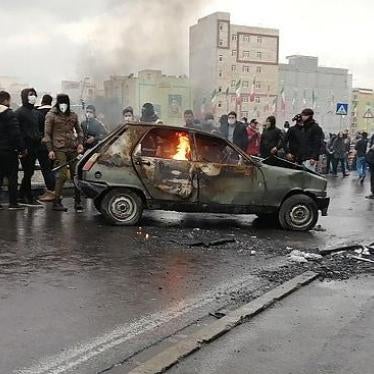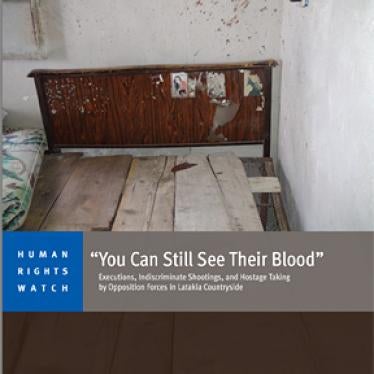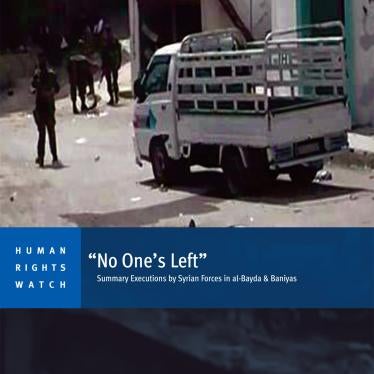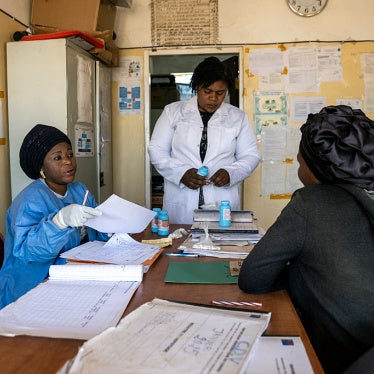(Antakya, Turkey) – Syrian government forces have endangered local residents by forcing them to march in front of the army during recent arrest operations, troop movements, and attacks on towns and villages in northern Syria.
Witnesses from the towns of al-Janoudyah, Kafr Nabl, Kafr Rouma, and Ayn Larouz in the Idlib governorate in northern Syria told Human Rights Watch that they saw the army and pro-government armed men, referred to locally as shabeeha, force people to march in front of the advancing army during the March 2012 offensive to retake control of areas that had fallen into the hands of the opposition. From the circumstances of these incidents, it was clear to the witnesses that the purpose of this was to protect the army from attack.
“By using civilians as human shields, the Syrian army is showing blatant disregard for their safety,” said Ole Solvang, emergencies researcher at Human Rights Watch. “The Syrian army should immediately stop this abhorrent practice.”
Kafr Nabl
“Abdullah,” a resident of Kafr Nabl, a town in the Jabal al-Zawiya region, told Human Rights Watch that the army forced him and several others to walk in front of their armored personnel carriers when they were conducting a search for wanted opposition activists on March 2. Like most of those interviewed he asked not to use his real name for fear of reprisals. He said:
As we were going to Friday prayer, soldiers from a base near the mosque were rounding up people. They took maybe 25 people, including me. There were also eight children, aged from 10 to 15, among us. They made us march in front and around the military vehicles to some houses where they were searching for wanted opposition activists. We marched for about 600 meters. They were insulting us the whole time. They arrested several people from the houses. Then they made us march back to their base, after which they released all of us, apart from the detained activists. The whole operation lasted for about two hours.
Abdullah said that the army often forced town residents to march alongside them, particularly when they needed to get food supplies.
Raed Fares, an opposition activist from Kafr Nabl, told Human Rights Watch that the Syrian army, which increased its presence in the town when demonstrations there begun seven months ago, started using civilians as human shields in January after opposition forces tried to attack the army with a roadside explosive device. Since then, he said, the soldiers have gathered residents and forced them to walk in front of the soldiers whenever they want to move around in the town. “They take anybody who opens the door when they knock,” he told Human Rights Watch. “It doesn’t matter whether it is a man, woman, or child.”
Fares shared with Human Rights Watch two videos that he has posted on YouTube. In the first video, filmed on February 23, about eight people in civilian clothes are walking in front of several armed soldiers and at least one infantry fighting vehicle.
In the second video, filmed on February 28, four people in civilian clothes are walking in front of a column of several infantry fighting vehicles on what appears to be the outskirts of the town. Fares said that the army had compelled the men to walk in front to protect the soldiers.
Human Rights Watch has not been able to verify the identity of the men independently. An alternative explanation, that they had been detained, seems unlikely since they are not handcuffed or blindfolded, a common practice during detention in Syria.
“Ahmed,” a resident from Kafr Nabl, also said that the army made civilians walk in front of them on a regular basis and described how the army used civilians when he was detained and transferred to the town of Ma`aret al-Nu`man, five kilometers away:
Two months ago, I was arrested in one of the demonstrations, together with 15 other people. They put us in police buses. From time to time, I glanced outside the car and saw around 30 villagers marching in front of the tanks. When we arrived to Ma`arat al-Nu`man, the army checked their identity [and] arrested those wanted by the police.
“Ibrahim,” a resident of Kafr Rouma, a town of about 20.000 people in the Jabal al-Zawiya area, described similar practices by the army in his town. He said it was common practice for the army to stop buses and cars, force people out, and make them march in front of the tanks and army cars when they wanted to move from one checkpoint to another (among seven around the city). As in Kafr Nabl, the army in Kafr Rouma also used women, children, and the elderly, he said. When they reached their destination, they would check people’s identification and release those who were not wanted, he said.
The army also used residents to protect its checkpoints. “Mahmoud,” a resident of the village of Jarjanaz, in the Idlib governorate, described the incident, which took place in early March, to Human Rights Watch:
I was driving with my cousin at the edge of the village in the direction of Ma`arat al-Nu`man when we saw a checkpoint with two tanks and soldiers at a distance of 800 meters in front of us. Both of us are wanted by the police, so we decided to turn back and park the car on a side street. After a moment, the army stopped a bus at the checkpoint. The passengers came out of the bus and stood in front of the tanks. The driver parked the bus in front of the military tent. Then we went back to the village and waited with the other villagers and the families of the passengers for nine hours before they came back with the bus. They told us that they had been forced to stand in front of the tanks the whole time.
Mahmoud explained to Human Rights Watch that opposition fighters had attacked the checkpoint about a week earlier, which made him believe that the army was using the local residents as protection against further attacks.
Al-Janoudyah
“Mustafa,” a resident of al-Janoudyah, a town just north of Jisr al-Shughour, told Human Rights Watch that the army forcibly used local residents in his town to protect the soldiers when conducting house searches and detentions after a Friday demonstration in mid-February:
After a Friday demonstration about a month ago, the army conducted house searches around 12:30 a.m. I was in one of the streets when I saw that the soldiers forced people out of their houses, put the men in police buses, and made women, children, and elderly people walk in front of the tanks followed by the other police buses transporting the detainees.
Mustafa said that the army was detaining people along the street leading to the public school, which the army was using as a detention facility. Afterwards, he talked to one of the people made to walk in front of the vehicles, who told him that they had been released when they arrived at the school.
Four opposition fighters previously based in the town of al-Janoudyah told Human Rights Watch in separate, detailed accounts that the army placed civilians in front of its tanks during its attack on the town on March 10, 2012. The opposition fighters said the army began its offensive around 5 a.m., advancing from three directions. For two hours the troops fired on the town from guns on armored personnel carriers and heavy machine guns mounted on tanks from a distance of three to four kilometers. “Mokhtar,” one of the opposition fighters described to Human Rights Watch what he saw:
I was positioned close to the al-Janoudyah road, from which the army was advancing on the village. I could see through my binoculars that when they reached the first houses at the limits of the village, the shabeeha accompanying the army started taking people out of their houses. From my position, I saw them taking about 20 people. They gathered them in front of the advancing tanks to protect themselves from the FSA. They made them march for 600 to 700 meters. Among them were children and old people. Then I could not see them anymore.
“Anas,” another opposition fighter, who observed the army’s entry into the village from a higher position than Mokhtar, gave a similar account:
I saw them taking about 50 civilians. When they arrived to the roundabout at the end of the street, they released some, but put others in cars, and took them away in the direction of the area controlled by the army. We heard later that they were detained in the school, which was controlled by the army. There were seven or eight women among the people made to walk in front of the vehicles and two or three children. We could not attack the army as we would have hurt our people if we had fired.
The two other opposition fighters gave similar accounts.
“Ghali,” an activist from al-Janoudyah, who was positioned on a hill overlooking the Yacoubya road, the second axis of the army advance, observed through binoculars that the army, when the soldiers reached the first houses on their route, started taking people out of their houses and forced them to walk in front of the tanks.
Ayn Larouz
Three witnesses interviewed by Human Rights Watch said that government forces placed children on tanks and inside security buses when they entered Ayn Larouz on March 10.
Two women who were in the town at the time told Human Rights Watch that they heard women shouting in the street when the army entered the town:
When we went out into the street we saw several tanks and buses. There were three or four children on each tank and in each bus. Several women were shouting at the soldiers and tried to grab the children from the tanks, but the soldiers were just kicking them away. We recognized children from all over the village, but most lived along the main street. We found out from the other mothers that the soldiers had come to their houses and taken the children. When the soldiers left the village, they left the children at the north side of the village.
A third witness who says that he observed the incident from just outside the town also said that the army placed children on top of tanks and in buses. The three witnesses said that the attack on the town and the invasion was carried out by forces based one kilometer north of Ayn Larouz, in the town of Arnaba.
Under international human rights law, state authorities who deliberately place individuals at grave risk to their life are violating their right to life, and such acts may also constitute cruel, inhuman, or degrading treatment. In situations of armed conflict in which international humanitarian law applies, "human shielding" is prohibited.
“The Syrian army’s use of human shields is yet another reason why the UN Security Council should refer Syria to the International Criminal Court” Solvang said. “Somebody should be made to answer for these violations.”







